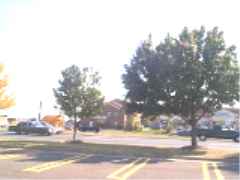
Near fatal damage of a forgotten tree tie. |

Comparison photo
|

Near fatal damage of a forgotten tree tie. |

Comparison photo
|
Staking Newly Planted Trees
A new tree has to be planted with the trunk as straight as possible. If the tree is leaning when planted, the lean will not correct itself over time. One needs only to take a walk in the woods to realize that nature does not stand back and walk around a new seedling to make sure it is perpendicular with the horizon. On the other hand, humans need this sense of order in the landscape. A tree with a leaning trunk just plain drives me crazy.
The school of thought in horticulture is that if a tree can be planted without benefit of staking, so much the better. The vibration in the root system originates from the winds blowing the crown (or branches) around. This vibration enhances root growth as the tree naturally attempts to anchor itself to the soil. In the event that heavy winds tilt the tree, simply loosen the root ball with a shovel and straighten the tree. This will do no harm as long as you are prompt in in the process. If the tree is taller than 8 feet or has a large branch structure, staking is probably needed.
The materials needed for staking are stakes and tying material. Generally, the stakes are made from wood. Shorter stakes (12 to 24") are used much like tent pegs. Tying lines can be strung from the tree's crown down to the peg to be snugly tied off. This method requires 3 stakes to give a "tee pee" effect. Longer stakes (4 to 8 feet) can be driven in on opposite sides of the tree. In this case, 2 stakes are needed and the tying material will be applied straight out from trunk to stake. Regardless of the method, the stakes should be driven in 2 or 3 feet away from the trunk, taking care not to drive the stake through the root zone, as damage might be done.
The tying materials should be a soft woven line such a broad nylon rope. The point is to avoid anything that might cut into the tree trunk. Wire may be used because it is sturdy and inflexible, but the wire must be inserted into rubber tubing (such as short sections of an old garden hose) so that the tubing can protect the truck from the wire. Tying materials need to be snug but not so tight as to cut into the tree.
All ties should not be in place for more than one year. After one
year, the roots should be adequately established so that support is no
longer needed. While the tree is staked, constant monitoring should
be practiced to insure that the growing trunk is not trying to absorb the
tie. The above photos illustrate what can happen when a tree is tied
and forgotten. This tree is actually located in Fredericksburg.
In 1997, an employee pointed out that the tree was dying, so we removed
the forgotten tie. The two trees shown were planted at the same time
but the little guy is stunted and weak because of strangulation by the
ties. This photo was taken today. See you next week.
Andy Lynn